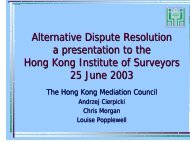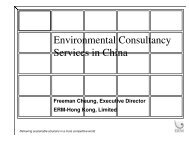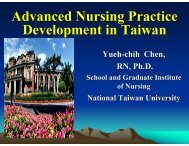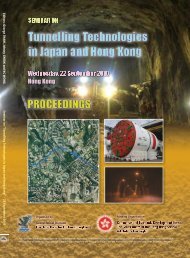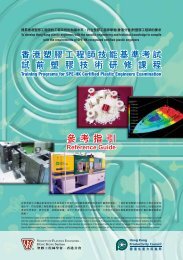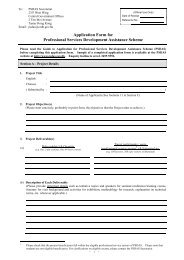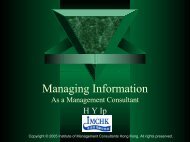RISK MANAGEMENT IN HOSPITAL FACILITY MANAGEMENT - A ...
RISK MANAGEMENT IN HOSPITAL FACILITY MANAGEMENT - A ...
RISK MANAGEMENT IN HOSPITAL FACILITY MANAGEMENT - A ...
Create successful ePaper yourself
Turn your PDF publications into a flip-book with our unique Google optimized e-Paper software.
<strong>RISK</strong> <strong>MANAGEMENT</strong> <strong>IN</strong> <strong>HOSPITAL</strong> <strong>FACILITY</strong> <strong>MANAGEMENT</strong><br />
- A CASE STUDY <strong>IN</strong> HONG KONG<br />
Mary WAN<br />
General Manager (Administrative Services),<br />
Pamela Youde Nethersole Eastern Hospital<br />
Ir Alfred SIT<br />
Chief Engineer, Electrical & Mechanical Services Department,<br />
Hong Kong SAR Government<br />
ABSTRACT<br />
The paper is about how Pamela Youde Nethersole Eastern Hospital of Hong Kong, with the<br />
support of the Electrical & Mechanical Services Department, developed a risk management<br />
strategy in the facility management services of its premises. The hospital, being an acute<br />
regional hospital serving the Hong Kong East region, is well known for pioneering new systems<br />
and good practices for its developments in facility management during the last decade. The<br />
paper will also demonstrate how risk management can help improve service quality and<br />
enhance the cost-effectiveness of facility management in a large public organization.<br />
Keyw ords: risk management, hospital<br />
PAMELA YOUDE NET HERSOL E EAST ERN <strong>HOSPITAL</strong><br />
The Hospital Authority (HA) of the Hong Kong Special Administrative Region (HKSAR) was<br />
established in December 1991 to assume responsibility for the management of all HKSAR<br />
government and subvented hospitals and health care institutions.<br />
Pamela Youde Nethersole Eastern Hospital opened in October 1993. It is a regional acute<br />
hospital with about 1,800 beds serving the population in Hong Kong East. As the hospital is<br />
the first to be opened after the establishment of the Hospital Authority, getting the “best” for the<br />
hospital was the common goal.<br />
Apart from healthcare, Facility Management (FM) is one of key services of the hospital. Its’<br />
strategic objective is defined as “the management of facility resources and services in support of<br />
the operations of the hospital”.<br />
<strong>RISK</strong> MANA GEM ENT PHILOSOPHY<br />
Hospitals are complex and tightly coupled systems that are quite prone to accidents.<br />
Concomitant with increasing legislation and public expectations, a new health care environment<br />
is emerging. The extent of the business risk borne by their facility management teams is very<br />
significant in hospitals. Business operations rely on a continuity of support for FM services.<br />
The risk to processes of patient care due to closures, breakdowns, and interruptions to support<br />
services must be better understood if downtimes are to be minimized.<br />
There are a number of FM tools and techniques for identifying, evaluating, treating, and<br />
monitoring risk. The general approach is to respond to the common hazard-based threats in<br />
isolation. The key to navigating a safe organisation lies in appreciating what is manageable<br />
and what is not. Merely struggling vainly to exercise direct control over accidents and incidents<br />
Conference in Hong Kong on 3 June 2004 ‘New World Order in Facility Management’<br />
HKIFM-PSDAS<br />
1
will result in risk management being seen as a negative factor in the business. If FM is seen<br />
as a business function, a broader view of risk should be considered and its impact on the<br />
business as a whole should be the main concern. Risk management should not be carried as<br />
an “add-on” exercise because it is part of general management. In a dynamic organisation like<br />
a hospital, a strategic approach in risk management addressing both management and<br />
technical issues should be adopted.<br />
<strong>RISK</strong> MANA GEM ENT STRAT EGY<br />
In developing a comprehensive risk management strategy to improve patient and staff safety,<br />
the hospital management recognizes the imperative to create an environment that encourages<br />
staff to identify errors, evaluate causes, and take appropriate actions to improve performance in<br />
the future. Like quality and value management, risk management is the responsibility of<br />
everyone in the organisation; the problem is to encourage everyone to play his/her part. Staff<br />
must be aware of the risks, but also of the steps that can be taken to prevent threats from<br />
becoming reality.<br />
SAFETY CULTURE<br />
Engineering a safety culture plays a critical role in the hospital where staff will not only<br />
understand it, but will accept, deliver, and find ways to promote it. There must be a strong<br />
commitment from top management in leading this cultural change. Messages stating that<br />
safety improvement is a serious priority of the hospital have to be consistent and repeatedly<br />
promulgated to all staff. In 1997, the Risk Management Committee chaired by the Hospital<br />
Chief Executive was set up so that a well-defined structure could be established to steer the<br />
movement in a coordinated manner throughout the various departments of the hospital. The<br />
governing board demonstrated its commitment through regular and close oversight of the safety<br />
of the hospital they shepherded. In fact, progress reports of risk management are a standing<br />
agenda item in governing board meetings.<br />
Commitment alone is not enough. A hospital needs to possess the technical competence to<br />
achieve its safety goals. Competence is closely related to the quality of its safety information<br />
system. Does it collect the right information? Does it disseminate it? Does it act upon it?<br />
In other words, our safety culture must be an informed culture.<br />
REPORT<strong>IN</strong>G CULTURE<br />
The most important barrier to improving safety is lack of awareness of the extent to which<br />
incidents and errors occur in hospitals. It is difficult to remedy problems that you do not know<br />
exist. The lack of awareness occurs because in most cases, incidents and errors are not<br />
reported.<br />
As for facility management services in hospitals, critical incidents reporting is a valuable tool in<br />
risk identification. It highlights risk areas previously overlooked, such as false fire alarms,<br />
water leakage damaging expensive medical equipment, frequent breakdowns of lift services,<br />
loss of property in wards, sewage and drainage problems in psychiatric wards, wet floors in<br />
kitchens, etc. We understand that persuading our staff to file critical incident or near miss<br />
reports is not an easy task. This depends on the willingness of individuals to report events in<br />
which they may have played a significant role. There are powerful disincentives for the staff to<br />
participate in a reporting scheme, such as extra work, a lack of trust, and fear of reprisals.<br />
What is needed is a just culture and an atmosphere of trust in which staff are encouraged to<br />
provide essential safety-related information. FM professionals need to foster a management<br />
style and develop a working culture in which communication flows freely regardless of the<br />
authority gradient. It is paramount for management to earn the trust of their staff and to<br />
motivate them to file incident reports.<br />
Conference in Hong Kong on 3 June 2004 ‘New World Order in Facility Management’<br />
HKIFM-PSDAS<br />
2
LEA RNI NG C ULT URE<br />
The goal of the reporting system is to analyze the information they gather and identify ways to<br />
prevent future errors from occurring. Collecting reports and not doing anything with the<br />
information serves no useful purpose. To drive the learning culture, the hospital designated a<br />
Hospital Incident Review Panel chaired by its chief executive to review the incidents and<br />
complaints. The composition of the panel included representatives from the clinical, nursing,<br />
allied health, and administrative departments. This was to ensure that when investigating<br />
incidents, staff would not miss important information, their diagnosis of root causes would be<br />
complete, and their remedies would be effective. For effective knowledge management, the<br />
improved actions and lessons learnt as identified in major incidents would be disseminated to<br />
and shared by all departments.<br />
CHALLENGES TO FM PROFESSIONALS I N <strong>RISK</strong> MA NAGEM ENT<br />
FM is still an emerging and new area in the development of health care. What are the<br />
challenges facing FM professionals in support of core business on risk management issues?<br />
In addition to their technical expertise, do they have the management knowledge and<br />
competence to develop workable solutions, to bridge the gap between promises and<br />
performance, and to realign their FM values when applying their solutions?<br />
I shall now demonstrate how our FM colleagues use the strategic approach to align users’<br />
needs in two priority risk areas.<br />
FIRE SA FET Y<br />
The occurrence of a fire in a hospital can result in serious consequences because of the<br />
difficulties and dangers in evacuating patients. Fire prevention is of utmost importance.<br />
In the past, our hospital’s fire safety plan was as follows:-<br />
Traditional Approach<br />
• Training<br />
• Generic in content<br />
• Not applicable to a health care setting<br />
• Isolated approach, conducted by different parties<br />
Safety talk – Community Section<br />
Drill & Debriefing – Operational Team<br />
Evacuation plan – Fire Protection Bureau<br />
• Reliance on Fire Services Department<br />
• Incident Report and Alert System<br />
• No structure incident reporting system<br />
• Management review of major incidents only<br />
• No data collection and analysis<br />
• No corporate-wide alert mechanism in place<br />
• Fire Services Installations<br />
• Only focused on meeting minimum legislative requirements (e.g. yearly<br />
inspections)<br />
• No regular monitoring of FS installation performance<br />
Conference in Hong Kong on 3 June 2004 ‘New World Order in Facility Management’<br />
HKIFM-PSDAS<br />
3
Feedback from users clearly reflected that our fire safety plan didn’t work. Why? It was<br />
because the fire risk in each department is unique and subject to the following factors:<br />
Env ironmental Design<br />
• Availability of fire service installations: smoke detectors, sprinkler systems,<br />
extinguishers<br />
• Availability of fire protection construction: fire compartments, fire exits<br />
• High rise buildings vs. low rise buildings (vertical evacuation vs. horizontal<br />
evacuation)<br />
Patient Condition<br />
• High mobility vs. low mobility (e.g. geriatric patients, orthopaedic patients, infants)<br />
• General patients vs. psychiatric patients<br />
• Reliance on life saving equipment (e.g. intensive care units, pediatric intensive care<br />
unit, renal patients)<br />
Tools & Equipment<br />
• Bed<br />
• Stretcher<br />
• Wheelchair<br />
• Baby cot<br />
• Evacuation mattress<br />
• Evacuation chair<br />
Eventually, our FM colleagues redesigned the comprehensive system on fire safety<br />
management.<br />
Current Approach<br />
• Training<br />
• Department specific<br />
• Focus on unique health care settings<br />
• Integrated approach by one single authority<br />
Safety talk<br />
Drill & Debriefing<br />
Evacuation plan<br />
• Train up hospital trainers<br />
• Incident Report and Alert System<br />
• Standardized incident reports to the Hospital Incident Review Panel and the<br />
Head Office<br />
• Management review – root causes and trend analysis<br />
• Head Office coordinates with various sections to issue fire incident alerts to<br />
other hospitals for sharing purposes.<br />
Conference in Hong Kong on 3 June 2004 ‘New World Order in Facility Management’<br />
HKIFM-PSDAS<br />
4
• Fire Services Installations<br />
• Monthly monitoring of FS installation performance<br />
• EMSD to provide system improvement advice<br />
<strong>HOSPITAL</strong> SEC URITY<br />
In 2000, the hospital’s management found that ward theft incidents had increased significantly.<br />
The Risk Management Committee examined the issue and concluded that there were serious<br />
inadequacies in the hospital’s security program, which contributed to unsafe conditions in the<br />
hospital.<br />
Traditional Approach<br />
• Policy & Procedure<br />
• Fragmented<br />
• Not updated to meet changing needs<br />
• Risk Assessment and Improvement Programs<br />
• No ri sk asse ssment<br />
• Accorded low priority by improvement initiatives<br />
• Incident Reporting<br />
• Isolated<br />
• No standardized reporting procedure<br />
• Not forwarded to senior management<br />
• No data collection and analysis<br />
• Safety Culture<br />
• Security was viewed solely as the Facility Management Department’s<br />
responsibility.<br />
With valuable input from expert agencies like the Crime Preventive Bureau and feedback from<br />
hospital users, the hospital’s FM team developed a strategic approach to security management.<br />
Current Approach<br />
• Policy & Procedure<br />
• Head Office provides the policy framework<br />
• FM team coordinates to issue up-to-date guidelines for colleagues<br />
• Risk Assessment and Improvement Programs<br />
• Continuous risk assessment to systematically identify risky areas<br />
• Prioritizing improvement initiatives based on risk level<br />
• Incident Reporting<br />
• Standardized reporting procedures<br />
• Root causes and trend analysis<br />
• Management review<br />
Conference in Hong Kong on 3 June 2004 ‘New World Order in Facility Management’<br />
HKIFM-PSDAS<br />
5
• Drawing up of specific improvement programs (e.g. ward theft prevention<br />
program: locking devices, patrols in high risk areas during high risk hours)<br />
• Safety Culture<br />
• Promote “Security is Everybody’s Business” concept (e.g. seminars on specific<br />
security issues, such as office and changing room security)<br />
Correction of these system failures has resulted in a significant drop in ward theft (property loss<br />
cases).<br />
Year 2000 2001 2002 2003<br />
Total Ward Theft/ 79 51 25 23<br />
Property Loss Incidents<br />
FM professionals have to recognise fire safety and security as an integral part of a hospital’s<br />
operation. Trying to design a safety program without taking into account the specific needs of<br />
clinical teams is likely to be an exercise in frustration, and will result in a waste of well-intended<br />
plans and energy.<br />
The importance of partnership with service providers in risk management should not be<br />
overlooked. Partnership is about establishing and strengthening relationships, raising the level<br />
of trust, and a mutual commitment to resolve problems and conflicts with a win-win attitude.<br />
Without the partnership attitude, service providers are likely to “cover up” problems and faults,<br />
and facility managers would be exhausted in policing their facilities to identify the inadequacies<br />
and shortcomings of service providers. Worst of all, service providers without long-term<br />
commitments would choose to ignore risks and treat problems identified as isolated cases;<br />
when the same event recurs, it may become an uncontrollably costly affair with damaging<br />
effects on the hospital.<br />
The Electrical and Mechanical Services Department (EMSD) of the HKSAR Government is the<br />
long-term strategic partner of the hospital in building facility management. The hospital and its<br />
partner share the same philosophy in risk management. The EMSD has established and<br />
implemented a critical incident reporting system in the hospital. Incidents leading to death or<br />
serious personnel injury and loss of property, major disruptions to hospital operations, and<br />
media attention are reported to the senior management of the EMSD as soon as practicable.<br />
Other less critical incidents are reported within 24 hours. The EMSD keeps the hospital<br />
continually informed of such incidents. Also, there are regular meetings between the hospital<br />
facility manager and the EMSD to discuss feedback and feed-forward views for continuous<br />
improvement. In addition, the EMSD has adopted a risk-based maintenance system as part of<br />
its facility management approach.<br />
THE ELECTRICAL AND M ECHANICAL SERVICES TRAD<strong>IN</strong>G FUND<br />
Under the EMSD is the Electrical and Mechanical Services Trading Fund (EMSTF), which was<br />
established in August 1996. Although it is part of the EMSD and hence part of the HKSAR<br />
Government, it operates on commercial principles and is accountable for its own profit and loss.<br />
It focuses on providing quality operation and maintenance services for engineering plants to<br />
government departments and public bodies in Hong Kong.<br />
Since its establishment, EMSTF has adopted proactive approaches in cost control, service<br />
quality enhancement, service diversification and partnership with customers. Comprehensive<br />
facility management service and risk management are two cornerstones among such strategic<br />
moves.<br />
Conference in Hong Kong on 3 June 2004 ‘New World Order in Facility Management’<br />
HKIFM-PSDAS<br />
6
<strong>RISK</strong> MANA GEM ENT FRAM EWORK<br />
In risk management, we follow the framework under the Australian/New Zealand Standard<br />
AS/NZS 4360:1999 to identify, analyze, evaluate, and treat risks. Like other established quality<br />
management systems, we stress the need for continuous improvements along the plan, do,<br />
check, and act (PDCA) cycle, and to consult, seek views, and communicate our findings/results<br />
to our clients, so as to continuously improve the system. An overview of our risk management<br />
framework is in line with AS/NZS 4360:1999.<br />
We would illustrate the adoption of risk management approach in two cases:<br />
a) maintenance of biomedical equipment; and<br />
b) occupational health and safety management in facility management.<br />
<strong>RISK</strong> MANA GEM ENT – MA<strong>IN</strong>T ENA NC E OF BI OMEDICAL EQUIPM ENT<br />
A hospital is equipped with a variety of specialized biomedical equipment such as defibrillators,<br />
resuscitators, surgical lasers, renal units, etc. for clinical purposes, patient treatment, and<br />
monitoring. Many of this equipment are mission critical, in that they are directly related to<br />
fulfilling the hospital’s mission and the life and death of patients. It follows that risk<br />
management on the maintenance of biomedical equipment was taken on board seriously right<br />
at the beginning.<br />
The objectives of the risk management system for biomedical equipment are:<br />
a) to minimize operation risk;<br />
b) to provide a decision making tool for better resource management; and<br />
c) to contain and/or reduce risks with existing resources.<br />
Once the objective and context of the risk management system are identified, the next steps<br />
would be to identify and evaluate the risks associated with each piece of biomedical equipment.<br />
In ranking or measuring risk, the AS/NZS 4360:1999 and the ECRI’s recommendation have<br />
been adopted. Risks are measured by a 3x3 risk matrix in this case based on:<br />
a) the likelihood/frequency of the risk occurring; and<br />
b) the impact/severity (consequences) should the risk occur.<br />
The likelihood/frequency of the risk is based on historical fault statistics, system design,<br />
professional knowledge, personnel experience in the equipment, and expert judgment. These<br />
are classified into three levels: likely, possible, and unlikely.<br />
Likelihood/Frequency Rating<br />
Likely Frequent major faults reported, excessive equipment shutdowns<br />
Possible Some major faults, short duration shutdowns<br />
Unlikely Some minor faults or no faults<br />
The impact/severity of the risk is assessed based on our experience and with inputs from<br />
medical professionals and nursing staff. These are classified into three levels: high, medium,<br />
and low.<br />
Impact/Severity Rating<br />
High Death/extensive injuries seriously affecting user’s operation (e.g. need to<br />
vacate wards/areas) and/or patient treatment, ECRI high risk device<br />
Medium Injuries affecting user’s smooth operation and/or patient treatment, ECRI<br />
medium risk device<br />
Low No injuries, inconvenience to user’s operation, waste of resources, ECRI low<br />
Conference in Hong Kong on 3 June 2004 ‘New World Order in Facility Management’<br />
HKIFM-PSDAS<br />
7
isk device<br />
The 3x3 risk assessment matrix below determines the Level of Risk (LOR) as high, moderate,<br />
or low based on impact/severity and the likelihood/frequency of the risk.<br />
Likelihood<br />
Consequence<br />
High Medium Low<br />
Likely High High Moderate<br />
Possible High Moderate Low<br />
Unlikely Moderate Low Low<br />
The initially assessed LOR is then reviewed and adjusted with due consideration according to<br />
the:<br />
a) condition of particular equipment, which may range from brand/new/good condition to<br />
aged/obsolete/poor condition;<br />
b) clinical operation impact of the equipment, which depending on the type of wards in<br />
which the equipment is located and/or the patients on whom the equipment is used,<br />
may range from highly critical to less critical even for the same type of biomedical<br />
equipment.<br />
c) occupational health and safety effect of the failed equipment to staff, patients, and the<br />
general public.<br />
Once the LOR has been assessed and adjusted, proper risk treatment measures are<br />
considered. Risk treatment measures can be categorized into two different types in this case:<br />
a) the maintenance level; and<br />
b) the contingency plan.<br />
In the maintenance of biomedical equipment, the range of maintenance strategy considered is:<br />
a) the proactive approach:<br />
• condition-based maintenance involving periodic equipment condition<br />
inspections, measurements, recording and data analyses, and the carrying out<br />
of corrective actions before equipment failure<br />
• time-based maintenance involving periodic equipment servicing, overhaul,<br />
calibration, and recommissioning.<br />
b) reactive maintenance:<br />
• corrective maintenance to be conducted when equipment failures occur<br />
• equipment replacement strategy involving little or no maintenance with failed<br />
equipment being replaced direct.<br />
When there is a choice of appropriate maintenance strategies for different levels of assessed<br />
risk, due considerations are also given to the following factors:<br />
a) safety to users and patients;<br />
b) statutory maintenance requirements, relevant guidelines, and international standards;<br />
c) clients/end user feedback; and<br />
d) availability of standby equipment and/or loaner units.<br />
Having considered the above, the optimum service modes generally adopted for high, medium,<br />
and low risk equipment are as follows:<br />
Conference in Hong Kong on 3 June 2004 ‘New World Order in Facility Management’<br />
HKIFM-PSDAS<br />
8
Risk Level<br />
Maintenance Service Modes<br />
High risk Periodic preventive maintenance (Levels 1 or 2)<br />
Medium risk Periodic safety checks<br />
Low risk Corrective maintenance or replacement strategy for low cost equipment<br />
In Hong Kong, there has up to been now few statutory requirements on biomedical equipment<br />
maintenance and safety. The EMSD, however, has adopted the best international practices,<br />
standards, and recommendations of relevant learned societies (e.g. ECRI) in delivering such<br />
maintenance services. Adopting a mix of proactive and reactive maintenance approaches, the<br />
different maintenance service modes above are as follows:<br />
Maintenance Serv ices Mode<br />
Electrical safety<br />
check<br />
Functional &<br />
Alarm Test<br />
Parameter Test<br />
and Calibration<br />
Preventive maintenance<br />
(Level 1)<br />
<br />
Preventive maintenance<br />
(Level 2)<br />
<br />
<br />
<br />
Safety Check <br />
As for the contingency plan, it addresses the service recovery measures in case equipment<br />
failures occur. The plan was devised jointly with end users. The options adopted are:<br />
a) providing loaner units;<br />
b) switching to alternatives, other facilities, and/or standby equipment;<br />
c) standing agreement with outside suppliers; and<br />
d) adopting no contingency plan for extra low risks and interruptions involved.<br />
Coupled with the contingency plan is a critical incident reporting system aimed at providing<br />
timely notifications to hospital management of critical incidents, and documenting procedures to<br />
mobilize the necessary resources for executing the contingency plan.<br />
The new risk-based maintenance arrangement was adopted in line with the ward-based<br />
preventive maintenance program. The new system avoids the end user’s need to transfer<br />
biomedical equipment within a ward back to the maintenance workshop on different dates for<br />
servicing. Instead, maintenance personnel bring with them necessary tools and instrument to<br />
conduct preventive maintenance for a variety of biomedical equipment within the same ward on<br />
a pre-appointed date. Feedback from end users on the service improvement approach has<br />
generally been very positive.<br />
With the risk management approach, we successfully achieved:<br />
a) the proper containment/minimization of risk to a pre-determined level;<br />
b) better resource allocation and prioritization and cost control; and<br />
c) the establishment of a high-quality and cost-effective service delivery mechanism<br />
meeting users’ expectations and operational needs.<br />
The new system succeeded in achieving a 10% cost reduction in the maintenance of biomedical<br />
equipment within a 3-year period.<br />
The adoption of a risk-based maintenance approach further enhances our communication with<br />
the hospital’s facility managers and frontline clinical users, with a shared ownership of the<br />
finalized risk management plan.<br />
In pursuit of continuous improvements leading towards service excellence, the established<br />
master risk assessment table and risk treatment measures are regularly reviewed and<br />
fine-tuned along the PDCA concept and risk management framework to suit changing<br />
Conference in Hong Kong on 3 June 2004 ‘New World Order in Facility Management’<br />
HKIFM-PSDAS<br />
9
circumstances, new equipment commissioned, new reports and findings from health safety<br />
alerts, etc.<br />
This risk management approach can also be applied to other building facilities, such as the<br />
electrical, mechanical, air-conditioning, building service plants, and systems and buildings in the<br />
hospital.<br />
<strong>RISK</strong> MANAGEM ENT - OCCUPATIONAL HEALTH AND SAFETY <strong>IN</strong> <strong>FACILITY</strong><br />
<strong>MANAGEMENT</strong><br />
Another example of risk management is in respect of occupational health and safety (OHS) in<br />
the delivery of facility management services. The objective is to provide means whereby job<br />
hazards and potential hazards are identified, evaluated, and managed so as to eliminate or<br />
reduce them to an acceptable level.<br />
Job Hazard Analyses (JHA) for identifying risks are conducted by Safety Officers registered by<br />
the HKSAR Labour Department and/or qualified officers conversant with site activities and the<br />
associated risks. The JHA includes all routine and non-routine activities carried out by the<br />
EMSD or its contractors/visitors, and covers premises such as offices, workshops, plant rooms,<br />
and customer-occupied areas. JHA are reviewed at least once a year or when there are<br />
substantial changes in the activities concerned.<br />
According to the results of the JHA, risk assessments were carried out via a 5x4 matrix<br />
approach, with 5 levels for likelihood and 4 levels for the consequences of each risk.<br />
For the likelihood of the risk, the 5 levels adopted are:<br />
a) Likely/Frequent: occurs repeatedly/event only to be expected;<br />
b) Probable: Not surprised, will occur several times;<br />
c) Possible: could occur sometimes;<br />
d) Remote: Unlikely, although conceivable;<br />
e) Improbable: so unlikely that the probability is close to zero;<br />
For the consequences of the risk, the 4 levels adopted are:<br />
a) Catastrophic: could result in fatality or detrimental property damage;<br />
b) Major: could result in major/extensive injuries or property damages;<br />
c) Minor: could result in minor injuries or property damage;<br />
d) Insignificant: could result in no injury or negligible damage;<br />
Consequences<br />
Catastrophic Major Minor Insignificant<br />
Likely/Frequent Extreme High High Moderate<br />
Probable High High Moderate Low<br />
Possible High Moderate Moderate Low<br />
Remote Moderate Moderate Low Low<br />
Improbable Low Low Low Low<br />
The recommended follow-up management actions for each of 4 risks are:<br />
a) Extreme risk: Immediate action is required to eliminate or reduce the risk.<br />
b) High risks: Urgent action is required and the work activity should not proceed unless<br />
Conference in Hong Kong on 3 June 2004 ‘New World Order in Facility Management’<br />
HKIFM-PSDAS<br />
10
appropriate risk control measures are in place.<br />
c) Moderate risk: Consider whether further practicable actions are available to<br />
eliminate or reduce the risk. Management responsibility for risk control and time<br />
frame for completion should be specified.<br />
d) Low risk: No additional risk control measure is needed, but monitoring is required to<br />
ensure that the existing controls are maintained effectively, and safety working<br />
procedures are followed.<br />
For work activities and situations where specific risk assessment requirements are prescribed<br />
by legislation, the legislative requirements are followed instead. These include aspects such<br />
as noise in the workplace, tasks which required to be handled manually, works in confined<br />
spaces, display screens, asbestos works, etc.<br />
In risk treatment, the following control measures in order of decreasing effectiveness and<br />
preference have been adopted to eliminate or reduce hazards identified with reference to the<br />
findings from the risk assessments, and with due consideration to cost effectiveness and<br />
practicability:<br />
a) elimination of hazards;<br />
b) substitution with something that is less hazardous or risky;<br />
c) engineering controls such as enclosures or safeguards to segregate hazards from<br />
people;<br />
d) a safe system of work that reduces the risks to an acceptable level;<br />
e) written procedures that are known or understood by the affected people;<br />
f) adequate supervision;<br />
g) provision of adequate training, information, and instructions to those affected;<br />
h) personal protective equipment.<br />
EMSD has adopted this risk management system for OHS matters and was certified to the<br />
OHS18001 since 2001. This is amongst the first few of such certifications granted in the<br />
HKSAR and the first among the HKSAR Government departments. The most encouraging<br />
outcome is the sustained reduction in accident rates in the past four years, as follows -<br />
Year<br />
Accident Rate<br />
(No. of reportable accident per 1000 staff)<br />
2000/01 26.2<br />
2001/02 17.6<br />
2002/03 16.8<br />
2003/04 14.8<br />
Note : The industrial-wide average accident rate in the HKSAR is 37<br />
reportable accidents per 1000 staff.<br />
CONCLUSION<br />
Risk management has been adopted in managing facilities and delivery of services in Pamela<br />
Youde Nethersole Eastern Hospital. This has been illustrated by examples in biomedical<br />
equipment maintenance, the management of occupation safety, and health in service delivery.<br />
Not only have there been improvements in service quality, but also improvements in cost<br />
controls to meet diminishing budgets. In risk management, the principles of teamwork,<br />
partnership with service providers, proactive and positive attitudes, and knowledge sharing have<br />
been crucial to this success.<br />
Conference in Hong Kong on 3 June 2004 ‘New World Order in Facility Management’<br />
HKIFM-PSDAS<br />
11
REFERENCES<br />
WAN YEUNG, K.S. Mary (1999), “Managing change: facilities management at the Pamela<br />
Youde Nethersole Eastern Hospital, Facilities Vol. 17, No. 3/4<br />
AS/NZS 4360: 1999 Risk Management, Standards Australian & Standards New Zealand<br />
Conference in Hong Kong on 3 June 2004 ‘New World Order in Facility Management’<br />
HKIFM-PSDAS<br />
12



